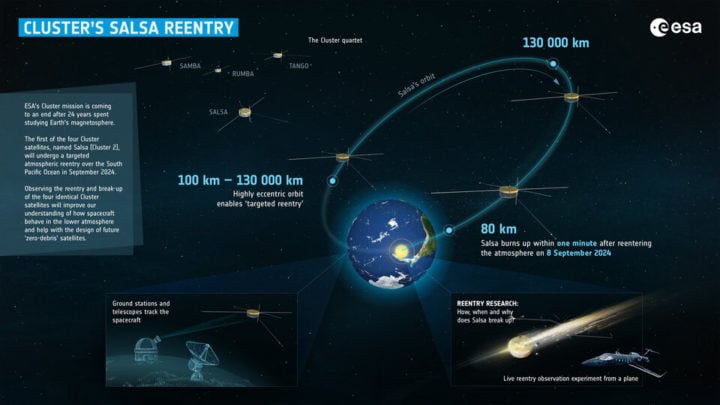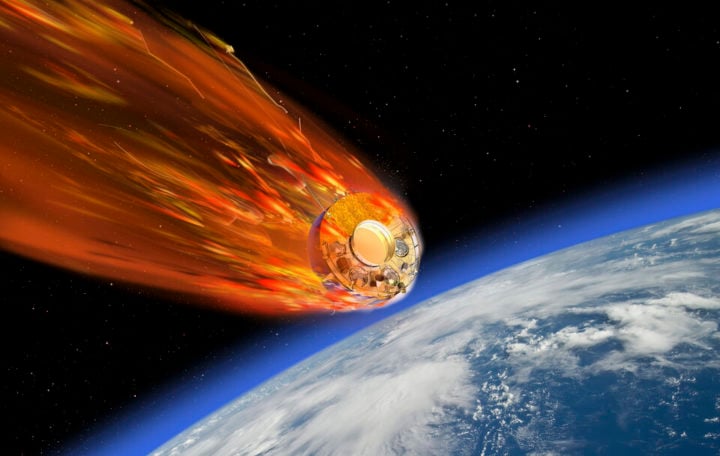The team needs a fixed time and a location to prepare the airborne observation experiment. A controlled reentry would make that a breeze, but Cluster was not designed with this capability.
The Cluster satellites’ highly eccentric orbit does allow a ‘targeted reentry’. Its highly eccentric orbit means Salsa is experiencing a large loss of altitude at its closest point to Earth (perigee) from orbit to orbit due to the gravitational influence of the Sun and Moon. It is no coincidence this happens during Salsa’s last orbits.

How Cluster’s reentry works
Big drops of over 30 km in altitude between one orbit and the next means that the team can pinpoint the exact orbit when Salsa will go so low that it crosses the threshold where satellites start to burn up, at around 80 km altitude. That is how they know it will reenter and burn up on 8 September.
“It’s because of this predictability in the reentry time and location that we can outfit a plane with scientific instruments and observe the reentry from as close as safely possible,” says Stijn.
“There is however one unknown: the atmospheric density as we go lower and lower. Therefore, over the next weeks, ground stations will keep listening for Salsa hoping it can send telemetry right until the end. Telescopes are also tracking the spacecraft, because minor deviations from its predicted trajectory, if there would be any, could be important for the flight plan from Easter Island.”
The in-flight experiment
It’s not easy to conduct an airborne, experimental observation campaign at a location picked because of its remoteness.


Ground track of Salsa’s reentry on 8 September 2024
“The airborne observation mission ‘ROSIE-Salsa‘ is a joint effort of academic partners from University of Stuttgart (IRS/HEFDiG), Comenius University in Bratislava (CUB), University of Southern Queensland (UniSQ) and industrial partners from Hypersonic Technology Göttingen (HTG) and Astros Solutions, in close cooperation with ESA,” says Jiří Silha, CEO of Astros Solutions.
“It is a very challenging mission due to the unpredictable nature of reentry events, which makes the reentry break-up prediction as well as the planning of the aircraft positioning for the best observation very demanding. However, with experts in both science and technical preparation, our team consists of exceptionally capable people who will ensure that once the object is in sight, we will get all the relevant scientific data we need.”
The plane will be mounted with the scientific instruments in Australia before making a test flight to check if everything is ready for the big event. Then the team moves to Easter Island to set up communications there and wait until it’s time to fly out and meet up with Salsa.
Onboard the plane will be the science lead from IRS/HEFDiG, the mission lead from UniSQ and mission participants from CUB and Astros Solutions, hoping to catch the reentry live. HTG supports the scientific analysis and modelling of the data as well as support the creation of the precise flight plan for the plane.
Each window of the plane will have cameras and spectrographs peeking out of them. All in all, over 20 scientific instruments will be looking for the explosion, tracking the fragments and recording as much detail as possible.


Cluster satellite reentering Earth’s atmosphere
Because the reentry takes place during the day, it will be harder to spot the reentry against the bright backdrop of the sky than it would be at night. It shortens the time that the scientists have to tune their instruments. It also makes it more complicated for some of the instruments that will have to quickly filter out the Sun’s radiation from the signals they are trying to catch.
It will be a tense wait until there is confirmation if the observation was a success. It might take a few minutes, or even hours, because of the limited connectivity on the plane and its extremely isolated location.
Reentry science into the future
The exciting opportunity to send a plane to observe reentries live from the air is rare and promises a wealth of data on how and when exactly satellites break up.


Final images of Aeolus during its brief phase as space debris
Cluster’s reentry follows those of ESA’s Aeolus and ERS-2 Earth observation missions. ESA is setting a precedent for a responsible approach to reduce the every-increasing problem of space debris and uncontrolled reentries with its Zero Debris approach, committing to stop the creation of space debris by 2030.
Until the end of November 2024, ESA operators will manoeuvre the three remaining Cluster satellites to line them up for reentries in similarly remote locations over the South Pacific Ocean. ‘Rumba’ (Cluster 1) will come down in November 2025, and ‘Samba’ (Cluster 3) and ‘Tango’ (Cluster 4) in August 2026.
“On top of the four Cluster reentries, we are also looking ahead to ESA’s exciting DRACO mission. With DRACO, we want to get the telemetry from a satellite recording what is happening from the inside during its own reentry,” says Tim Flohrer, Head of the Space Debris Office at ESA.
“DRACO will be an actively controlled reentry of a satellite that is fitted out with a ‘black box’ that will provide the telemetry for us to learn from. If all goes well, we’re hopeful that we can have similar airborne observation campaigns of these reentries in the future.”
Source: European Space Agency

